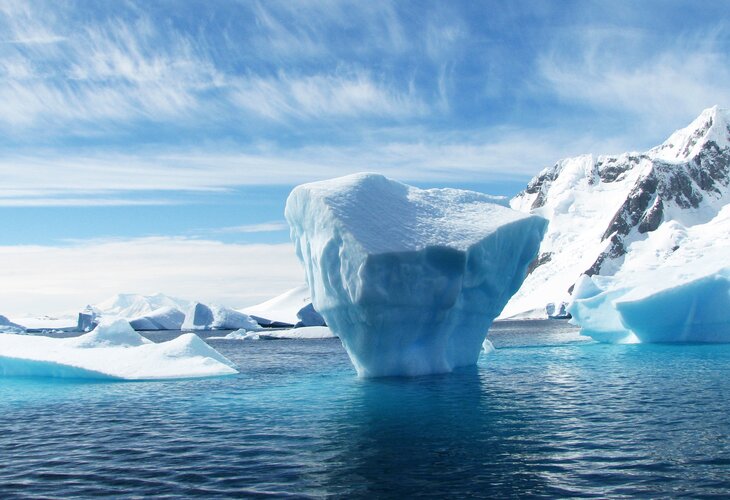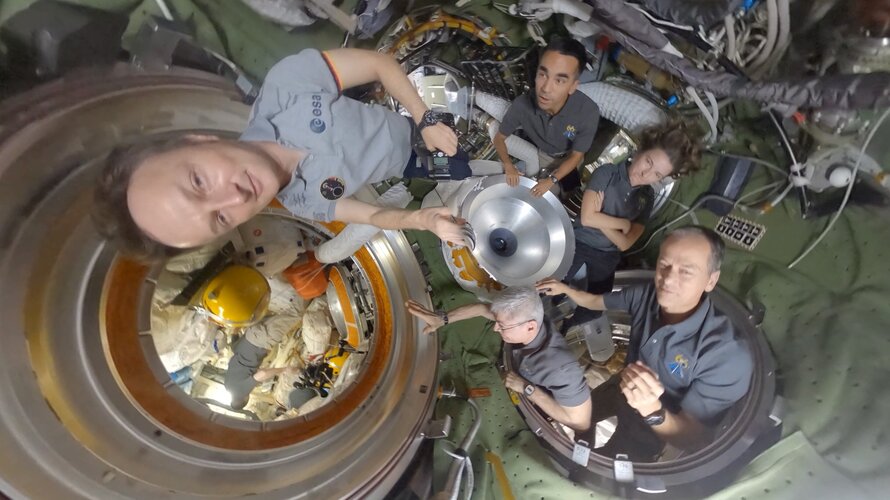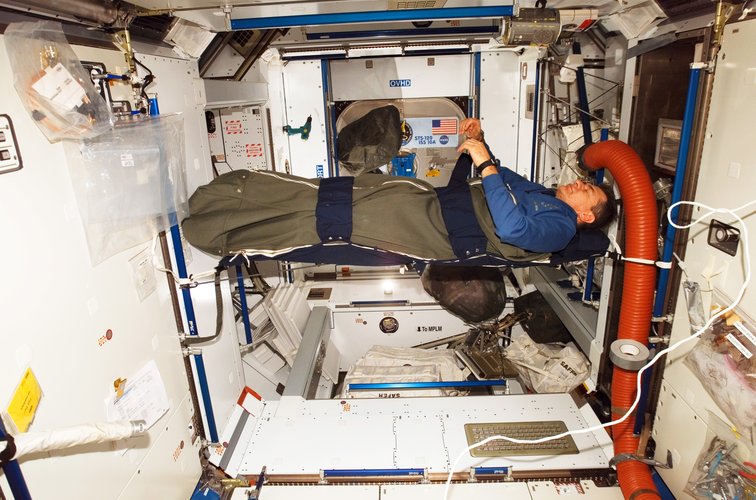
Copernical Team
Get to grips with analysing climate data

Satellites provide crucial, and increasingly important, information to help understand our changing climate. However, better understanding Earth observation data can be a daunting task for new users. A new online course, developed by the University of Twente, on behalf of ESA, helps students, researchers and other professionals analyse satellite data to help measure and mitigate against the effects of climate change.
Hello and goodbye in 360° | Cosmic Kiss
 Video:
00:02:58
Video:
00:02:58
Spaceflight participants Yusaku Maezawa and Yozo Hirano and Russian cosmonaut Alexander Misurkin were welcomed to the International Space Station on 8 December 2021 for a 12 day stay in space. Experience their arrival and farewell in 360° as captured by ESA astronaut Matthias Maurer from within the Russian segment.
Also seen in this video are Expedition 66 Commander Anton Shkaplerov, Roscosmos cosmonaut Pyotr Dubrov and NASA astronauts Mark Vande Hei, Raja Chari, Tom Marshburn, and Kayla Barron.
Matthias was launched to the International Space Station for his six-month ESA mission known as Cosmic Kiss on 11 November 2021. During
Hibernate for a trip to Mars, the bear way

Hibernating astronauts could be the best way to save mission costs, reduce the size of spacecraft by a third and keep crew healthy on their way to Mars. An ESA-led investigation suggests that human hibernation goes beyond the realm of science-fiction and may become a game-changing technique for space travel.
Study probes Earth's turbulent past to explain where oceans came from
 The origin of water on our planet is a hot question: Water has immense implications for plate tectonics, climate, the origin of life on Earth, and potential habitability of other Earth-like planets. In a recent study in Physical Review Letters, a Skoltech professor and his Chinese colleagues suggest a chemical compound that - although now extinct - could have preserved water deep underground in
The origin of water on our planet is a hot question: Water has immense implications for plate tectonics, climate, the origin of life on Earth, and potential habitability of other Earth-like planets. In a recent study in Physical Review Letters, a Skoltech professor and his Chinese colleagues suggest a chemical compound that - although now extinct - could have preserved water deep underground in The secrets of ancient Japanese tombs revealed thanks to satellite images
 A research group at the Politecnico di Milano analysed the orientation of ancient Japanese tombs - the so-called Kofun. This study has never been carried out before, due to the very large number of monuments and the fact that access to these areas is usually forbidden.
For these reasons, high-res satellite imagery was used. The results show that these tombs are oriented towards the arc of
A research group at the Politecnico di Milano analysed the orientation of ancient Japanese tombs - the so-called Kofun. This study has never been carried out before, due to the very large number of monuments and the fact that access to these areas is usually forbidden.
For these reasons, high-res satellite imagery was used. The results show that these tombs are oriented towards the arc of Hunga Tonga-Hunga Ha'apai Erupts
 A powerful volcanic eruption has obliterated a small, uninhabited South Pacific island known as Hunga Tonga-Hunga Ha'apai. Damage assessments are still ongoing, but preliminary reports indicate that some communities in the island nation of Tonga have been severely damaged by volcanic ash and significant tsunami waves.
The volcano had sporadically erupted multiple times since 2009. The most
A powerful volcanic eruption has obliterated a small, uninhabited South Pacific island known as Hunga Tonga-Hunga Ha'apai. Damage assessments are still ongoing, but preliminary reports indicate that some communities in the island nation of Tonga have been severely damaged by volcanic ash and significant tsunami waves.
The volcano had sporadically erupted multiple times since 2009. The most "Rivers" in the sky likely to drench East Asia under climate change
 It's been becoming more and more clear that global warming means more than just warmer temperatures. Extreme weather events are becoming more frequent and more intense in many different parts of the world, creating an urgent need to predict and prepare for these changes.
In a new study published in Geophysical Research Letters, a research team led by the University of Tsukuba has reported
It's been becoming more and more clear that global warming means more than just warmer temperatures. Extreme weather events are becoming more frequent and more intense in many different parts of the world, creating an urgent need to predict and prepare for these changes.
In a new study published in Geophysical Research Letters, a research team led by the University of Tsukuba has reported China completes health check on BDS satellite constellation
 A health check on all 52 in-orbit satellites of China's BeiDou Navigation Satellite System (BDS) has been completed, according to the Xi'an Satellite Control Center.
The center said the satellites met all key indicators, meaning the constellation can provide services without issue.
The evaluation was conducted without interrupting the satellites' usual navigation services, and develo
A health check on all 52 in-orbit satellites of China's BeiDou Navigation Satellite System (BDS) has been completed, according to the Xi'an Satellite Control Center.
The center said the satellites met all key indicators, meaning the constellation can provide services without issue.
The evaluation was conducted without interrupting the satellites' usual navigation services, and develo China's high-resolution multi-mode imaging satellite put into use
 China's high-resolution multi-mode imaging satellite has been officially put into use, according to the China National Space Administration (CNSA) Thursday.
The satellite was launched on July 3, 2020 from the Taiyuan Satellite Launch Center in north China's Shanxi Province. The summary review of its in-orbit test was completed on December 17, 2021.
The test results show that the sate
China's high-resolution multi-mode imaging satellite has been officially put into use, according to the China National Space Administration (CNSA) Thursday.
The satellite was launched on July 3, 2020 from the Taiyuan Satellite Launch Center in north China's Shanxi Province. The summary review of its in-orbit test was completed on December 17, 2021.
The test results show that the sate ICEYE US Wins Contract To Participate in National Reconnaissance Office's Broad Agency Announcement For Commercial Radar
 ICEYE US, a subsidiary of ICEYE, the global leader in persistent Earth monitoring with radar satellite imaging, announced that it has received a contract from the National Reconnaissance Office (NRO). This contract enables ICEYE US to participate in the NRO's evaluation of commercial remote sensing companies operating synthetic aperture radar (SAR) satellites.
With a focus on modeling and
ICEYE US, a subsidiary of ICEYE, the global leader in persistent Earth monitoring with radar satellite imaging, announced that it has received a contract from the National Reconnaissance Office (NRO). This contract enables ICEYE US to participate in the NRO's evaluation of commercial remote sensing companies operating synthetic aperture radar (SAR) satellites.
With a focus on modeling and 
